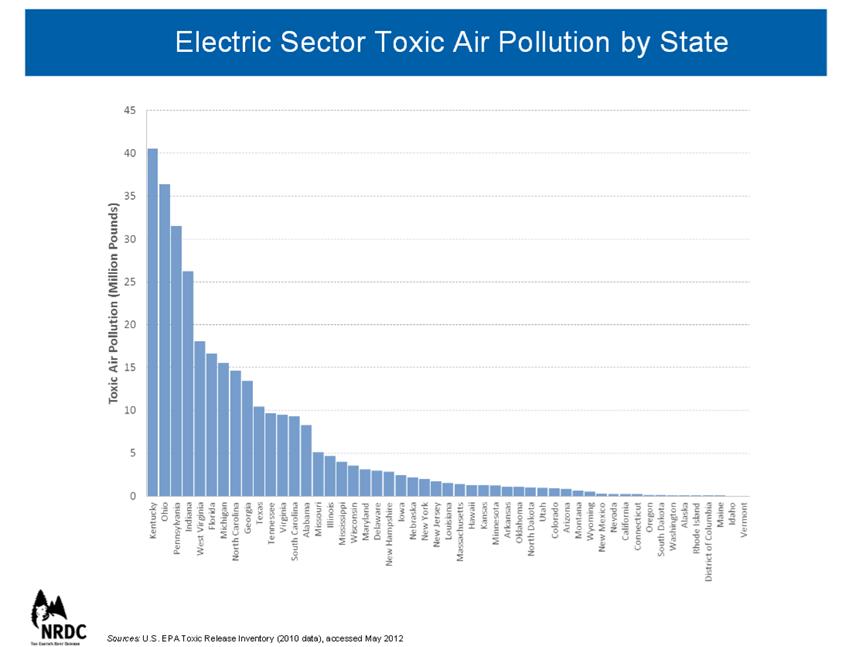CT Among Best in Nation with Lowest Toxic Air Pollution; KY, OH, PA Among Worst
/
Residents of Kentucky, Ohio and Pennsylvania are exposed to more toxic air pollution from coal-fired power plants than in any other state, according to an analysis by the Natural Resources Defense Council (NRDC), leading the organization’s “toxic 20.”
At the same time, the report found a 19 percent decrease in all air toxics emitted from power plants in 2010, the most recent data available, compared to 2009 levels. Connecticut ranks 42nd in toxic air pollution and 43rd in mercury air pollution according to the newly released data, among the lowest levels in the nation.
a 19 percent decrease in all air toxics emitted from power plants in 2010, the most recent data available, compared to 2009 levels. Connecticut ranks 42nd in toxic air pollution and 43rd in mercury air pollution according to the newly released data, among the lowest levels in the nation.
The drop in toxic levels nationwide is attributed to two factors: the increasing use by power companies of natural gas, which has become cheaper and is cleaner burning than coal; and the installation of state-of-the-art pollution controls by many plants--in anticipation of new health protections issued by the Environmental Protection Agency (EPA).
Finalized in 2011, EPA’s Mercury and Air Toxics standards will cut mercury air pollution by 79 percent from 2010 levels, beginning in 2015. Connecticut is one of only 13 states to have electric sector mercury regulations that are at least as stringent as the EPA’s proposed utility air toxics rule, according to the report.
Toxics standards will cut mercury air pollution by 79 percent from 2010 levels, beginning in 2015. Connecticut is one of only 13 states to have electric sector mercury regulations that are at least as stringent as the EPA’s proposed utility air toxics rule, according to the report.
In the second edition of “Toxic Power: How Power Plants Contaminate Our Air and States,” NRDC also found that coal- and oil-fired power plants still contribute nearly half (44 percent) of all the toxic air pollution reported to the Environmental Protection Agency’s Toxics Release Inventory (TRI). The report also ranks the states by the amount of their toxic air pollution levels.
Among Connecticut’s neighboring states, New Hampshire at #21, New York at #24 and Massachusetts at #27 narrowly missed being included in the “toxic 20”. Rhode Island was #47, Maine was #49 and Vermont was #50.
Newly installed EPA Administrator Gina McCarthy, a former Connecticut Commissioner of Environmental Protection, has spent the past four years with responsibility over EPA’s air pollution regulations as the assistant administrator of the EPA's Office of Air and Radiation.
With pollution reductions resulting from the upcoming standard, it is estimated that as many as 11,000 premature deaths and 130,000 asthma attacks, 5,700 hospital visits, 4,700 heart attacks, and 2,800 cases of chronic bronchitis will be avoided in 2016. The public health improvements are also estimated to save $37 billion to $90 billion in health costs, and prevent up to 540,000 missed work or “sick” days each year.
Franz Matzner, NRDC associate director of Government Affairs, said: “For too long, Americans have had no choice but to breathe toxic air pollution. Thanks to the EPA, the air is getting cleaner.” Despite the overall reductions in total emissions, 18 of the Toxic 20 from 2009 remain in the 2010 list, although several states have made significant improvements highlighted in the report. The states on the "Toxic 20" list (from worst to best) are:
- Kentucky
- Ohio
- Pennsylvania
- Indiana
- West Virginia
- Florida
- Michigan
- North Carolina
- Georgia
- Texas
- Tennessee
- Virginia
- South Carolina
- Alabama
- Missouri
- Illinois
- Mississippi
- Wisconsin
- Maryland
- Delaware






























